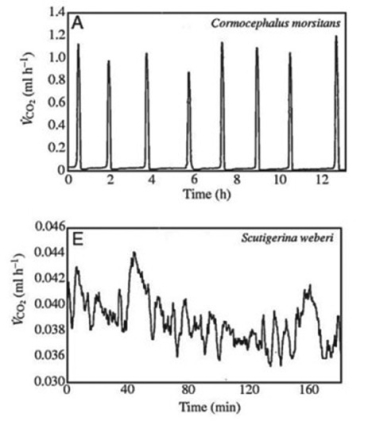Many terrestrial arthropods exchange gases with their environments by using tracheae, tubes that lead from openings (called spiracles) in the animal's exoskeleton or cuticle directly to the animal's tissues. Some arthropods can control whether their spiracles are opened or closed; opening the spiracles allows the carbon dioxide produced in the tissues to travel down the tracheae and be released outside the animal. Klok et al. measured the carbon dioxide emitted over time (represented by VCO₂) by several species of centipedes. The figures present graphs of their results for two species, Cormocephalus morsitans and Scutigerina weberi. (C. J. Klok, R. D. Mercer, and S. L. Chown. 2002. Discontinuous gas-exchange in centipedes and its convergent evolution in tracheated arthropods. Journal of Experimental Biology 205:1019-29.) Copyright 2002 The Company of Biologists and the Journal of Experimental Biology. 
Look at the graph for Scutigerina weberi (note the scale of the y-axis) in the figure.
- What is the best interpretation of these results?
A) The centipede had its spiracles open the entire time.
B) The centipede had its spiracles closed the entire time.
C) The centipede had its spiracles open when carbon dioxide (CO₂) emission peaked and closed when CO₂ emission was low.
D) The centipede had its spiracles closed when carbon dioxide (CO₂) emission peaked and open when CO₂ emission was low.
Correct Answer:
Verified
Q45: Imagine that you are a research chemist
Q48: Toilets are a modern convenience that people
Q49: Use the following information to answer the
Q50: Many terrestrial arthropods exchange gases with their
Q51: Many terrestrial arthropods exchange gases with their
Q54: The heartworms that can accumulate within the
Q56: Imagine that you are a graduate student
Q57: Without genetic variation, evolution cannot occur. Sexual
Q58: A terrestrial animal species is discovered with
Q58: Whiteflies are common pest insects found on
Unlock this Answer For Free Now!
View this answer and more for free by performing one of the following actions

Scan the QR code to install the App and get 2 free unlocks

Unlock quizzes for free by uploading documents